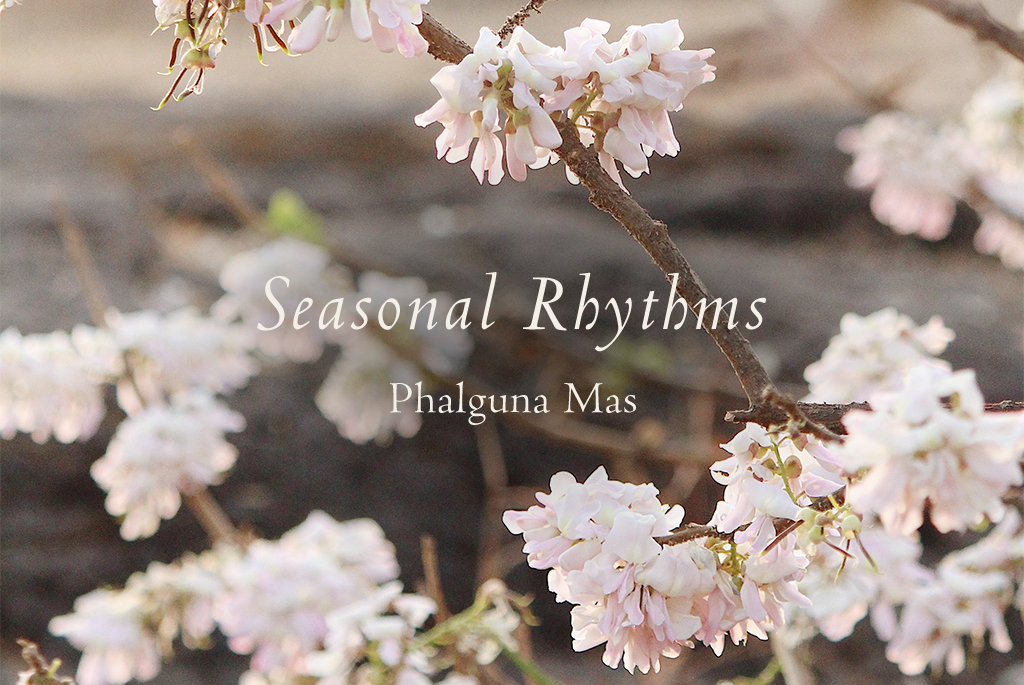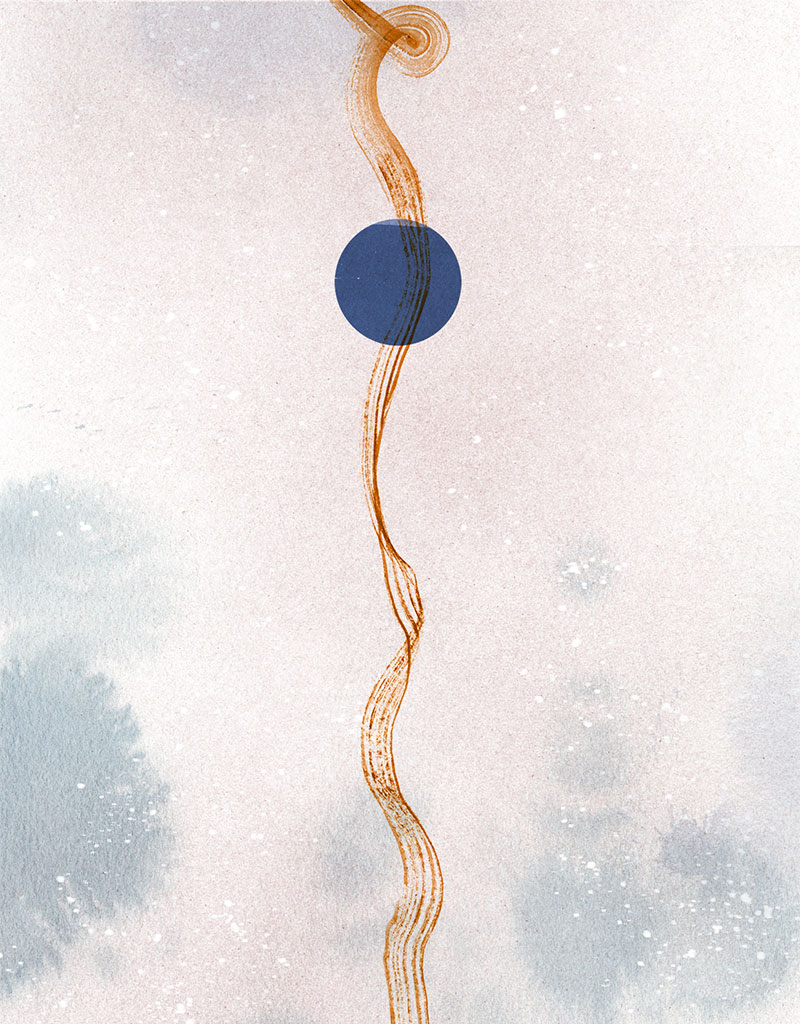Nilakshi Sharma

There is poignancy to the month of Phalguna. It is the month of both, endings and new beginnings. As the last month of Shishir rtu and of the annual Indian calendar, Phalguna is a month that straddles two different worlds.
On the one hand there is the last of the lingering chill of winters and the welcomed sweet warmth of the Sun which reminds us that we are at last putting the winter season behind us. On the other hand, the vibrancy of tender new shoots and the first of the blooms, swaying gently in sudden gusts of winds are precursors of the oncoming new rtu – Basant.
Phalguna literally translates as the ‘fruit’ (phal) of ‘quality or virtues’ (guna). In a sense, it is a month of taking stock – as we bid farewell to the Rtu Chakra (traditional year) that this month brings to a close. Mental, physical and emotional health are always the result of incremental improvement as a result of consistent practices and routines that nourish our bodies and minds, and this is a good month to see what has worked for us in the eleven months gone by and what we need to address and then to look towards creating the right practices and routines for ourselves that will help us achieve the state of wellbeing we wish to be in.
Beautiful Transitions
Nowhere is the transitional beauty of Phalguna more apparent than in trees. In this month the mighty Peepul tree will shed every single one of its leaves. And then a few days later, tender reddish green leaves will begin to burst forth on the bare branches. Meanwhile the red Semal flowers (aka the Malabar Silk Cotton tree) will carpet the ground. And deep in the forests, the Palash or the Flame of the Forest will be ablaze with its orange flame-like flowers. The tribals of central and northern India describe the blooming of these flame-like flowers they call Dhal (Palash) flowers as a forest fire that signifies the arrival of the festivities of Holi, the festival of colours. Rabindranath Tagore famously compared the bright orange flame-like Palash flowers to fire.
Holi: The Festival of Kama and Colour
When the Palash flowers bloom, Holi is around the corner. In Sanskrit the Flame of the Forest is known as Kimsukha – the name comes from comparing the distinctively shaped blossoms to the curve of a parrot’s beak. The blooming of Palash flowers is constantly used in Sanskrit literature and poems to announce the arrival of Spring and the season of love. Kimsukha flowers are also inextricably linked to the god of love – Kama, he who arrives astride a Parrot and strikes the hearts of all with flower-tipped arrows of desire. Among the oldest origin myths of the festival of Holi is that of Kama’s death and rebirth.
While trying to help Parvati in her attempt to espouse Shiva, Kama loosens his arrows of desire at Shiva, who is in a deep meditative trance and thus oblivious to the desires and requests of Parvati. Even as Kama readies his arrows, the first stirrings of Basant rtu are felt because Kama and Basant rtu are best friends – where one goes, the other follows. And so the day of Kama’s attempt to make Shiva desire Parvati is marked and celebrated as Basant Panchami.
However, Shiva, in his anger at his meditative trance being disturbed, opens his third eye and incinerates Kama. This is followed by 40 days of prayers and laments by the very gods themselves, led by Rati, Kama’s wife. Moved by her anguish, Shiva relents and Kama is reborn on the Full Moon of Phalguna, and this day is celebrated as Holi.
The Three-eyed God – Tryambakam
Phalguna month is also the time of Shiva. Maha Shivratri – the night of Shiva is celebrated with prayers and rituals across the length and breadth of the subcontinent. This year, Maha Shivratri comes on March 8.
Some legends say that this is the day of the union of Shiva and his consort – Parvati, others say that on this day the complementary energies of Shiva and Shakti converge. It is traditional to chant the Mahamritunjaya mantra on this day. Literally the name translates as ‘the great death-conquering chant’. The Mahamritunjaya mantra appears in the Rig Veda, Yajur Veda and Atharva Veda. It is also known as Rudra mantra, referring to Shiva in the form of Rudra, and Tryambakam mantra, addressed to the three-eyed one, that is, Shiva.
ॐ त्र्यम्बकं यजामहे सुगन्धिं पुष्टिवर्धनम् |
उर्वारुकमिव बन्धनान्मृत्योर्मुक्षीय माऽमृतात् ||
oṃ tryambakaṃ yajāmahe sugandhiṃ puṣṭi-vardhanam
urvārukam iva bandhanān mṛtyor mukṣīya mā 'mṛtāt
Loosely translated it means: ‘We worship the Three-eyed Lord who is fragrant and who nourishes and nurtures all beings. As a vine ripened fragrant fruit (with the intervention of the gardener) is freed from its bondage (to the creeper), may he liberate us from death for the sake of immortality.’
Rituals of Cleansing
Phalguna, which is considered a deeply auspicious month, also brings to a close the annual rtu chakra or cycle of seasons. And the month itself is a time of tremendous transitions. The Kapha dominant environment of winters now gives way to time of Vata dominance. While winter is a time of strong digestive fires, it is also a time of Kapha accumulation. As Phalguna takes us towards the energy of Basant rtu, it is important to note the impact of this change on our bodies.
Just as we spring clean our homes in anticipation of Holi, it is important for us to also cleanse our bodies of the Kapha accumulation at this time. Just as the snows begin to thaw as Spring draws closer, so too the Kapha accumulation in our bodies begins to thaw now. If we do not take care of this we become more prone to congestions, change of season flu, and allergies. We can do this by strengthening our digestive Agni, which is also important because Basant rtu is a time of weakening digestive Agni.
Here are some traditional and Ayurvedic self-care and food practices that allow our bodies and minds to transition.
- Tart Delight: Eating foods with sour taste such as Amla is beneficial at this time of the year. It helps in eliminating Ama (Ayurvedic term for the toxins that accumulate in our bodies as a result of improper digestion etc.) A stimulant for the liver, the vitamin C-rich Amla also helps boost immunity. Some of the side benefits of drinking Amla juice or eating it daily are visible in healthier skin and hair. For a potent health shot you can combine the juice of Amla with a measure of Ginger juice, which will help stimulate you digestion and strengthen your digestive capacity. As per a nutritionist, Amla-Ginger juice, especially if you take it when your stomach is empty, “refreshes and reboots your system”. Since Amla is rich in iron, it will also help increase your iron levels and decrease fatigue. One of the two Ekadashis of the month of Phalguna is also celebrated as Amlaki (traditional name of Amla) Ekadashi. Amla can be had fresh with a little rock salt if you like sour taste. Or you can juice it and have an Amla juice shot of about 60 ml on an empty stomach in the morning. You can also add a measure of fresh Ginger juice for a truly potent health drink.
- Bitter Benefits: Traditionally in the two weeks before Holi, the fresh, tender new Neem leaves were consumed on an empty stomach. The bitter Neem offers a veritable treasure trove of health benefits. A decoction of Neem leaves can help in reducing Kapha and encourage the elimination of Ama. Neem encourages better liver function and has a purifying effect on blood. Neem also kindles Agni and encourages our metabolism. Its bitterness also serves to strengthen our sense of taste and offer oral health benefits.
Neem Tea: Boil 5 to 10 Neem leaves in 1 ½ cup of water and simmer till reduced to 1 cup. But the very potency and power of Neem mean that we must observe the traditional caution in its consumption – this general consumption of Neem was only advocated for the last fortnight of Phalguna.
Please note the following:
- If you are pregnant or on any medication for blood pressure, heart, diabetes, etc., please consult a physician before eating Neem.
- Do not consume Neem for more than a few days without an Ayurvedic physician’s advice.
- Abhyanga: The traditional Ayurvedic practice of daily self-massage with gently warmed oil is one of the most beneficial rituals of self care. It helps activate our skin’s energy, encourages better blood circulation and offers a gentle push towards better Ama elimination as well.
- Jal Neti: The Yogic practice of irrigating the nasal passages with saline water, is also highly beneficial at this time, especially if you suffer from congestion and seasonal allergies.
May this Rtu Chakra come to a close for you on a note of health and happiness.





